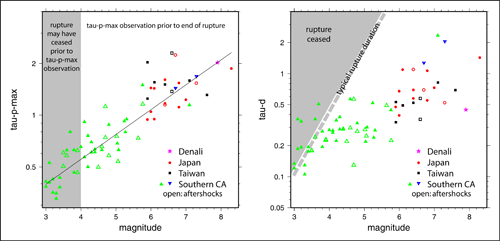
| Home |
| Research |
| Downloads |
| Publications |
| Teaching |
| People |
| Press |
| Allen CV |
| Seismo Lab |
| Earth & Planetary |
| UC Berkeley |
The deterministic nature of earthquake rupture
Erik L. Olson
University of Wisconsin Madison
Richard M. Allen
University of California Berkeley
Nature, 438, 212-215, doi:10.1038/nature04214
Understanding the earthquake rupture process is central to our understanding of fault systems and earthquake hazards. Multiple hypotheses concerning the nature of fault rupture have been proposed but no unifying theory has emerged (1-12). The conceptual hypothesis most commonly cited is the cascade model for fault rupture (1,3,10,13). In the cascade model, slip initiates on a small fault patch and continues to rupture further across a fault plane as long as the conditions are favourable. Two fundamental implications of this domino-like theory are that small earthquakes begin in the same manner as large earthquakes and that the rupture process is not deterministic--that is, the size of the earthquake cannot be determined until the cessation of rupture. Here we show that the frequency content of radiated seismic energy within the first few seconds of rupture scales with the final magnitude of the event. We infer that the magnitude of an earthquake can therefore be estimated before the rupture is complete. This finding implies that the rupture process is to some degree deterministic and has implications for the physics of the rupture process. more...
Download a reprint:
pdf
Download a supplementary information:
pdf
Download the scaling relation fig (above):
pdf
See also Rachel Abercrombie's accompanying News and Views piece: pdf
For application to earthquake warning systems visit www.ElarmS.org
